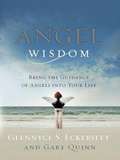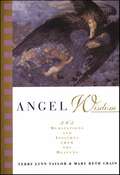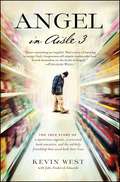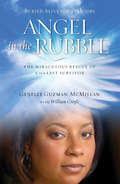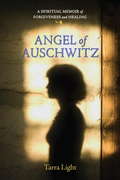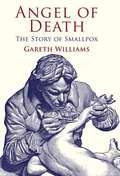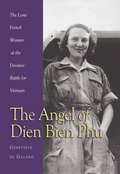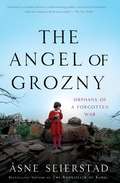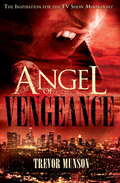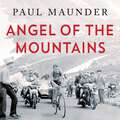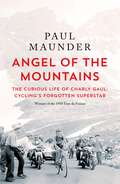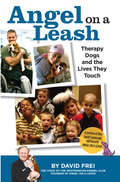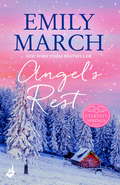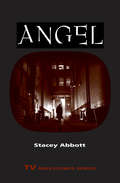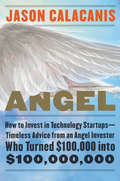- Table View
- List View
Angel Wisdom
by Gary Quinn Eckersley Glennyce S.Since the dawn of time, angels have been there for us, by our sides through bad times and good. In these two divinely inspired books, international angel experts take readers on a heavenly journey that will help them attract angels into their lives? and keep them near forever. In this blessed book, Glennyce Eckersley and Gary Quinn reveal the most precious wisdom there is on living a full and contented life: angel wisdom. Readers will discover a heavenly host of angels?angels of healing and angels of guidance, angels of joy and angels of hope?and incredible true stories of individuals whose lives have been changed forever through their wisdom and guidance. Also provided are detailed instructions on attracting angels into your own life with beautiful angelic affirmations, visualizations, and blessings. Angel Wisdom will help bring the timeless knowledge and grace of angels into your life. .
Angel Wisdom: 365 Meditations and Insights from the Heavens
by Terry Lynn TaylorLike a guardian angel whispering in your ear…'Angel Wisdom' puts you in touch with the warmth, encouragement, and insight of your heavenly helpers every day.Some say angels- intermediaries from on high- have always been among us to
Angel Words: Visual Evidence Of How Words Can Be Angels In Your Life
by Doreen Virtue Grant VirtueWhen Doreen and her son Grant Virtue were recording podcasts, they noticed that whenever she said the word angel, the recording graphics were shaped like angel wings! So they studied the other words she said and realized that those with a spiritual or loving basis had large graphs. So they experimented with saying negative words and found that their appearance was completely different: tight and small. Similar to Masaru Emoto's work with water crystals, Angel Words gives visual proof of the power and impact of speaking in a loving way. You'll come to understand why positive words express the most energy and therefore have the most power to manifest your dreams. You'll also see how negative words have low energy and read how they can actually draw negative experiences to you. This unforgettable book will immediately motivate you to choose positive words!
Angel at Her Shoulder: Lillian Dickson and Her Taiwan Mission
by Kenneth L. WilsonAngel at Her Shoulder is more than the title of an amazing story and the biography of a most remarkable, physically undersized but spiritually large woman. Lillian Dickson, the irresistible "Lil" of this book, who has been accurately named: "Typhoon Lil," has practiced and demonstrated the faith "once delivered" as no other mortal I have ever known. In these chapters we find her building hospitals, orphanages, schools, a leprosarium, churches, and mountain clinics with a courage that at times plunged ahead against what seemed to be, even to her most devoted associates, insuperable odds. This accurate and eloquently-written story tells the amazing record of this small woman, who was pyramid-high in love with the helpless and hapless. The author has been captured by his subject and Mrs. Dickson by Taiwan, South America, Mainland China, and the world could not have been more fortunate in her biographer.
Angel in Aisle 3
by Kevin West Frederick EdwardsIn the tradition of An Invisible Thread and Same Kind of Different as Me, Angel in Aisle 3 is the heartwarming true story of an unlikely friendship that began with a chance meeting in a grocery store between a bank executive bound for prison and an elderly stranger.When Kevin West resigned from his job as vice president of a bank in 1998 after making fraudulent loans, he spent the time before his trial managing a family-owned, small grocery store in Ironton, Ohio. Dealing with serious marriage problems and with a prison sentence almost certainly in his future, Kevin was overcome with remorse and without a scrap of hope. It was at his lowest moment that Kevin called out to a power beyond himself for help, and God answered his prayer in the form of an elderly vagrant in a soiled shirt and tattered pants named Don. When Don saw Kevin's open Bible on the counter next to the register, the untidy, long-haired indigent took the opportunity to share Bible wisdom and life-giving truths that changed Kevin's life. Finding a sense of peace in their conversation, Kevin offered Don a few basic groceries and an invitation to continue their conversation the next day. What began as a chance meeting between two individuals whose lives seemed headed for certain ruin, turns into an unlikely bond of friendship that saved them both. It was this friendship that helped Kevin thrive in prison, restore his failed marriage, and gave Don a chance at a new life that went beyond anyone's imagination. Moving and awe-inspiring, this story of a pure friendship sheds light on the redemption and hope that can grow out of relationships based in faith.
Angel in the Rubble
by Genelle Guzman-McmillanThe Miraculous Gift of a Second Chance Am I dead? But I was in too much pain to be dead, right? I put my left hand right up to my face, but I couldn't see even a hint of it. As I lay on my right side, my right arm and leg were pinned underneath me. A huge slab of concrete pressed against my head. Mustering all my strength, I pushed against it. Nothing. With my left hand, I could feel that an immense steel beam encased the rest of my body. I was sealed in a coffin of concrete and steel. I screamed for help, but my voice went nowhere. I was alone. Completely alone. ' For twenty-seven hours, Genelle remained below the surface of Tower One's rubble. During this time, she couldn't help but reflect on the life she'd lived and how she'd drifted from the faith she once knew. One of her most painful regrets was that she'd left her daughter behind in Trinidad while she pursued her dream of singing and dancing in America. As death now seemed certain, she feared where it would take her. And then she remembered witnessing the miraculous recovery of her aunt when she was a child in Trinidad. Maybe . . . just maybe, God had a miracle for her as well. For hours she prayed, remembering each detail of her walk away from the faith she'd known as a child. She begged God to forgive her--accepting that she may soon die, but praying for the miracle of life and a chance to live that life with a new purpose and direction. God answered her prayer by sending an angel to sustain her. Now living in the light, Genelle is making good on the promises she made in the dark while buried in the rubble.
Angel in the Whirlwind: The Triumph of the American Revolution
by Benson BobrickAngel in the Whirlwind is a dramatic narrative of the American Revolution illuminated by fresh insight by noted historian Benson Bobrick.
Angel of Auschwitz
by Tarra LightNatasza Pelinski is a young Polish Jew taken to Auschwitz. Her childhood stolen from her, she quickly matures and in the process discovers she has psychic gifts. She develops a relationship with the ghost of a professor, who becomes her spirit guide. He in turn enlists her aid on a mission of salvation for the Jewish people. As well as helping her survive in the brutal conditions of the camp, he teaches Natasza the secret of healing and how to move past anger toward compassion. She forms the Sisters of Light, a group of young women who, although they have few medicines to offer, bring gifts of love and forgiveness to their fellow prisoners. They form a bond of the heart that sustains them and keeps them connected through the horror of their daily existence. Author Tarra Light was raised in an East Coast Jewish family but had little knowledge of the Holocaust while growing up. During past-life regression therapy in 1996, she began to access a previous life as an inmate at Auschwitz. Her newly unlocked memories form the basis of this eloquent testimony to the power of the spirit in the most dire circumstances.
Angel of Bataan: The Life of a World War II Army Nurse in the War Zone and at Home
by Walter MacdougallAlice Zwicker was the only service woman from Maine to be a prisoner of the enemy in either of the two World Wars. But there is more to the story than that. Across the nation, wherever one of the seventy-seven Angels of Bataan returned home, there was a hero&’s welcome. Those Army and Navy nurses had shown what American women could do and be, even in times of defeat. This is Alice&’s story: her growing up in a small Maine town, her commitment to the profession of nursing, and her immersion in World War II. There was Manila, Bataan, Corregidor, and then three long, hungry years when she was held prisoner by the Japanese. For Alice, the terrible legacy of war did not end with her liberation from internment camp, or even with her coming home. When victory finally arrived for Alice, it was achieved in her own soul.
Angel of Darkness: The True Story of Randy Kraft and the Most Heinous Murder Spree
by Dennis McdougalRandy Kraft was highly intelligent, politically active, loyal to his friends, committed to his work--and the killer of 67 people--more than any other serial killer known. This book offers a glimpse into the dark mind of a living monster. "To open this book is to open a peephole into hell".--Associated Press.
Angel of Death: The Story of Smallpox
by Gareth WilliamsThe story of the rise and fall of smallpox, one of the most savage killers in the history of mankind, and the only disease ever to be successfully exterminated by a public health campaign.
Angel of Dien Bien Phu
by Genevieve De GalardAs the only French woman among some 11,000 defenders at Dien Bien Phu, Geneviève de Galard had a unique perspective of the siege and fall of the French fortress. This memoir about her years as a flight nurse for the French air force offers previously unknown details about their defeat. De Galard was on the flights that evacuated casualties from the battle, often landing in the midst of Vietminh artillery barrages. After a French air force C-47 with de Galard on board was seriously damaged, she tended to the wounded and dying in a field hospital. Her efforts won her the Knight's Cross and the Croix de Guerre, and from the American press the name Angel of Dien Bien Phu. Following a tickertape parade in New York, President Eisenhower awarded her the Presidential Medal of Freedom in 1954. Now, Americans can learn the full story.
Angel of Grozny: Orphans of a Forgotten War
by Asne SeierstadIn the early hours of New Year's Eve, 1994, Russian troops invaded the Republic of Chechnya, plunging the country into a prolonged and bloody conflict that continues to this day. Asne Seierstad was a foreign correspondent in Moscow at the time, and travelled regularly to Chechnya to report on the war, describing its effects on those trying to live their daily lives amidst the violence. In 2006 and 2007 she returned, travelling in secret, under constant danger. The tragedy in Chechnya had continued, but the world had moved on, its attention on other conflicts. In a broken, devastated society, she meets the orphans, the wounded, the lost. And she meets the children of Grozny, those who will shape their country's future. What happens to a child who grows up surrounded by war, who grows accustomed to violence? Whose childhood is ruined? A compelling, intimate and often heartbreaking portrait of Chechnya today, The Angel of Grozny also offers a vivid account of its violent history, and its ongoing battle for freedom.
Angel of Vengeance
by Trevor O. MunsonThe novel that inspired the TV series Moonlight puts a twist on the classic Dracula vampire tale and blends it with Chandler hardboiled P.I. detective fiction.LA-based P.I. and vampire Mick Angel has been hired by a beautiful red-headed burlesque dancer to find her missing sister. But the apparently simple case of a teenage runaway is soon complicated by drug dealers, persistent cops, murder, and Mick's own past. Mick must learn the hard way what every vampire should know - nothing stays buried for ever, especially not the past.
Angel of Vengeance: The Girl Who Shot the Governor of St. Petersburg and Sparked the Age of Assassination
by Ana SiljakIn the Russian winter of 1878 a shy, aristocratic young woman named Vera Zasulich walked into the office of the governor of St. Petersburg, pulled a revolver from underneath her shawl, and shot General Fedor Trepov point blank. "Revenge!," she cried, for the governor's brutal treatment of a political prisoner. Her trial for murder later that year became Russia's "trial of the century," closely followed by people all across Europe and America. On the day of the trial, huge crowds packed the courtroom. The cream of Russian society, attired in the finery of the day, arrived to witness the theatrical testimony and deliberations in the case of the young angel of vengeance. After the trial, Vera became a celebrated martyr for all social classes in Russia and became the public face of a burgeoning revolutionary fervor. Dostoyevsky (who attended the trial), Turgenev, Engels, and even Oscar Wilde all wrote about her extraordinary case. Her astonishing acquittal was celebrated across Europe, crowds filled the streets and the decision marked the changing face of Russia. After fleeing to Switzerland, Vera Zasulich became Russia's most famous "terroristka," inspiring a whole generation of Russian and European revolutionaries to embrace violence and martyrdom. Her influence led to a series of acts that collectively became part of "the age of assassinations." In the now-forgotten story of Russia's most notorious terrorist, Ana Siljak captures Vera's extraordinary life story--from privileged child of nobility to revolutionary conspirator, from assassin to martyr to socialist icon and saint-- while colorfully evoking the drama of one of the world's most closely watched trials and a Russia where political celebrities held sway.
Angel of the Mountains: The Strange Tale of Charly Gaul, Winner of the 1958 Tour de France
by Paul Maunder'Maunder's book is more than just a biography of the rise and fall of a complicated man . . . It is also a critique of the damage that myth-making and the media can do to an athlete; a study of what happens to a demigod when thrown from Mount Olympus' The TimesCharly Gaul is a forgotten cycling legend. Once a household name across Europe, the diminutive Luxembourger won the 1958 Tour de France and the Giro d'Italia twice. A unique rider, Gaul was supremely gifted at climbing and resilient even in the foulest weather. His pedalling style was smooth and swift, and he could set an unmatchable metronome rhythm on a mountain climb. 'Mozart on two wheels,' was how one contemporary writer described him; another dubbed him 'The Angel of the Mountains'.At the end of his cycling career Gaul disappeared, becoming a hermit living in a forest in Luxembourg. What drove Charly Gaul into a recluse's life? In Angel of the Mountains, Paul Maunder seeks to uncover the truth about Gaul, his psychology and the circumstances of his withdrawal from society. In rediscovering Gaul's enigmatic life, we find not only an unlikely hero but also a larger truth about the nature of sporting success.
Angel of the Mountains: The Strange Tale of Charly Gaul, Winner of the 1958 Tour de France
by Paul Maunder'Maunder's book is more than just a biography of the rise and fall of a complicated man . . . It is also a critique of the damage that myth-making and the media can do to an athlete; a study of what happens to a demigod when thrown from Mount Olympus' The TimesCharly Gaul is a forgotten cycling legend. Once a household name across Europe, the diminutive Luxembourger won the 1958 Tour de France and the Giro d'Italia twice. A unique rider, Gaul was supremely gifted at climbing and resilient even in the foulest weather. His pedalling style was smooth and swift, and he could set an unmatchable metronome rhythm on a mountain climb. 'Mozart on two wheels,' was how one contemporary writer described him; another dubbed him 'The Angel of the Mountains'.At the end of his cycling career Gaul disappeared, becoming a hermit living in a forest in Luxembourg. What drove Charly Gaul into a recluse's life? In Angel of the Mountains, Paul Maunder seeks to uncover the truth about Gaul, his psychology and the circumstances of his withdrawal from society. In rediscovering Gaul's enigmatic life, we find not only an unlikely hero but also a larger truth about the nature of sporting success.
Angel of the Mountains: The Strange Tale of Charly Gaul, Winner of the 1958 Tour de France
by Paul Maunder'Maunder's book is more than just a biography of the rise and fall of a complicated man . . . It is also a critique of the damage that myth-making and the media can do to an athlete; a study of what happens to a demigod when thrown from Mount Olympus' The TimesCharly Gaul is a forgotten cycling legend. Once a household name across Europe, the diminutive Luxembourger won the 1958 Tour de France and the Giro d'Italia twice. A unique rider, Gaul was supremely gifted at climbing and resilient even in the foulest weather. His pedalling style was smooth and swift, and he could set an unmatchable metronome rhythm on a mountain climb. 'Mozart on two wheels,' was how one contemporary writer described him; another dubbed him 'The Angel of the Mountains'.At the end of his cycling career Gaul disappeared, becoming a hermit living in a forest in Luxembourg. What drove Charly Gaul into a recluse's life? In Angel of the Mountains, Paul Maunder seeks to uncover the truth about Gaul, his psychology and the circumstances of his withdrawal from society. In rediscovering Gaul's enigmatic life, we find not only an unlikely hero but also a larger truth about the nature of sporting success.
Angel on a Freight Train: A Story of Faith and Queer Desire in Nineteenth-Century America
by Peter C. BaldwinAngel on a Freight Train examines the experiences of Samuel Edward Warren (1831–1909), a teacher and college professor in Troy, New York, who struggled to reconcile his same-sex erotic desires with his commitment to a Christian life. Unlike twenty-first-century evangelicals who try to "pray the gay away," Warren discerned no fundamental conflict between his faith and his attraction to younger males. Growing up in the antebellum Northeast, in a culture that permitted and even celebrated emotional bonds between men, he strove to build emotionally intense relationships in many overlapping forms—friendship, pedagogy, evangelism, and romance—which allowed him to enjoy intimacy with little effort at concealment. However, as he passed into mature manhood and built a prestigious career, Warren began to feel that he should have grown out of romantic friendships, which he now feared had become emotionally and physically excessive.Based on Warren's deeply introspective and previously unexplored diaries, Angel on a Freight Train traces his youthful freedom and sensuality, his attempt to join with younger men in a spirit of loving mentorship, and, finally, the tortured introspection of a man whose age seemed to shut him out from an idyllic lost world. In the end, Warren came to believe rather sorrowfully in a radical division between his angelic, ideal self and what he called "the freight train of animal life below."
Angel on a Leash: Therapy Dogs and the Lives They Touch
by David FreiDavid Frei, the publicist of Westminster Kennel Club and the founder of Westminster's therapy dog charity, Angel on a Leash, along with his wife Cheri, a minister at Morgan Stanley Children's Hospital of New York-Presbyterian, retell heartwarming stories of therapy dogs who change the lives of needy children at hospitals and rehabilitation centers. angelonaleash.org
Angel's Rest: A heartwarming, uplifting, feel-good romance series (Eternity Springs)
by Emily MarchIf you love Robyn Carr's Virgin River, don't miss Emily March's warm, uplifting Eternity Springs series!Angel's Rest is the first novel in New York Times bestselling author Emily March's warm and uplifting romance series about a small town with a big heart. For fans of Debbie Macomber, Holly Martin and Sheryl Woods.Gabriel Callahan has lost everything that mattered. All he wants is solitude on an isolated mountain estate. Instead, he gets a neighbour. Vibrant, no-nonsense Nic Sullivan is Eternity Springs' veterinarian, and she has an uncanny plan to lure this talented architect back to the world of the living. First with a dog, next with a renovation project, and, finally, with a night of passion that ends with a surprise. Now a man still raw from tragedy must face the biggest struggle of his heart. Can he forgive himself and believe in the power of second chances? Dare he trust in the promise of a future and a brand-new family here in Eternity Springs?Escape to Eternity Springs, a little piece of heaven in the Colorado Rockies, with the other books in the series, Hummingbird Lake, Heartache Falls, Mistletoe Mine, Lover's Leap, Nightingale Way, Reflection Point, Miracle Road, Dreamweaver Trail, Teardrop Lane, Heartsong Cottage, Reunion Pass, Christmas In Eternity Springs.
Angel: Angel
by Stacey AbbottExamines the innovative approach to genre, aesthetics, narrative, and the representation of masculinity in the television series Angel.
Angel: How to Invest in Technology Startups—Timeless Advice from an Angel Investor Who Turned $100,000 into $100,000,000
by Jason CalacanisOne of Silicon Valley’s most successful angel investors shares his rules for investing in startups.There are two ways to make money in startups: create something valuable—or invest in the people that are creating valuable things.Over the past twenty-five years, Jason Calacanis has made a fortune investing in creators, spotting and helping build and fund a number of successful technology startups—investments that have earned him tens of millions of dollars. Now, in this enlightening guide that is sure to become the bible for twenty-first century investors, Calacanis takes potential angels step-by-step through his proven method of creating massive wealth: startups.As Calacanis makes clear, you can get rich—even if you came from humble beginnings (his dad was a bartender, his mom a nurse), didn’t go to the right schools, and weren’t a top student. The trick is learning how angel investors think. Calacanis takes you inside the minds of these successful moneymen, helping you understand how they prioritize and make the decisions that have resulted in phenomenal profits. He guides you step by step through the process, revealing how leading investors evaluate new ventures, calculating the risks and rewards, and explains how the best startups leverage relationships with angel investors for the best results. Whether you’re an aspiring investor or a budding entrepreneur, Angel will inspire and educate you on all the ins of outs. Buckle up for a wild ride into the world of angel investing!
AngelList
by Liz Kind Ramana NandaIn early 2010, Naval Ravikant and Babak Nivi posted a list of angel investors on the Venture Hacks blog as a resource for founders looking for funding prior to seeking venture capital. The list quickly evolved into AngelList, a separate matchmaking platform for founders and investors to make early stage fundraising more efficient. By June 2013, AngelList had garnered substantial media attention, and was used by many high profile angel investors and venture capitalists. It had approximately 100,000 startups and 18,000 accredited investors. Since the site was launched, almost 40 startups on AngelList had been acquired, and over 2,000 startups had been funded. For most entrepreneurs, posting a profile on AngelList had become as commonplace as setting up a personal profile on Facebook or LinkedIn. Most recently, the site added Invest Online, a new product that in partnership with SecondMarket, allowed accredited investors to make small investments-as low as $1,000-in startups at the same terms as larger investors.While the co-founders were proud of AngelList's growth, as of June 2013, they were not charging for its use and had not yet determined its business model. Ravikant and Nivi wondered if they should reconsider and have AngelList apply for broker dealer status so it could charge transaction fees, but they were reluctant to enter what they considered a regulatory minefield. The recently passed JOBS Act was expected to relax constraints around crowdfunding, and Nivi and Ravikant knew that would be a logical extension for AngelList as well. Finally, they wondered if they should avoid any potential regulatory issues altogether and instead focus on generating revenue primarily from recruiting and other ancillary services.
AngelList in 2017
by Ramana Nanda Robert F. WhiteAngelList in 2017 by Ramana Nanda, Robert F. White and Liz Kind
